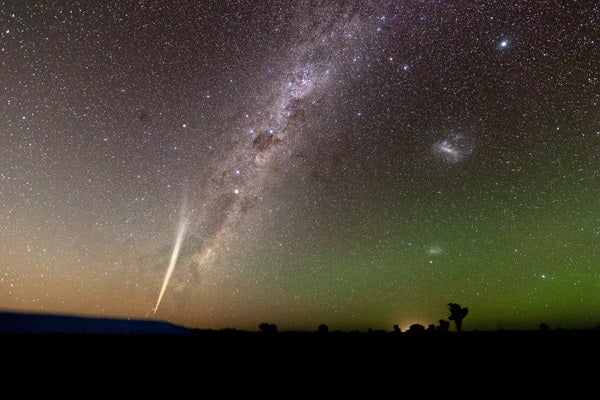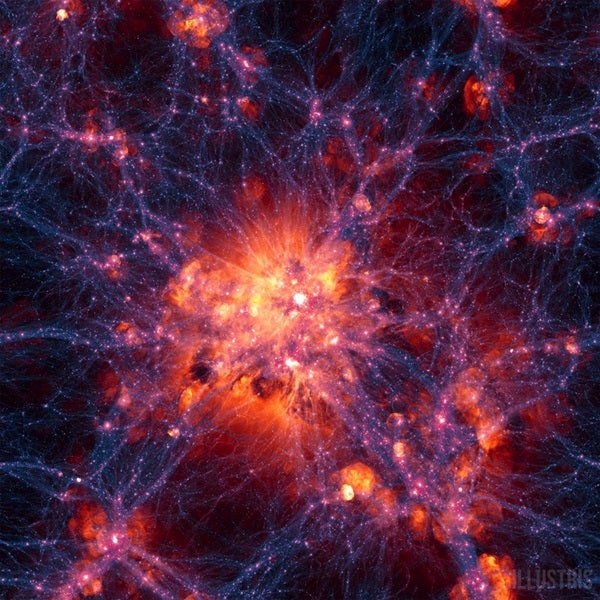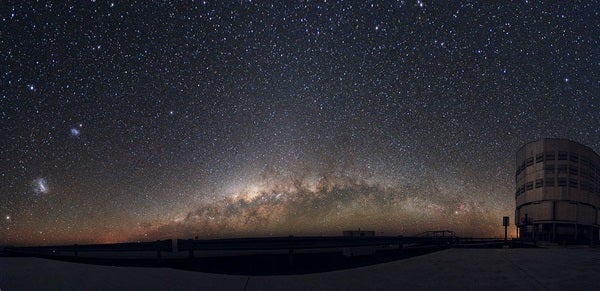From utilizing gravitational lensing to studying hypervelocity stars, researchers have experimented with a number of methods to pin down our galaxy’s mass. But given our limited knowledge, it’s not surprising that the results have varied from a few hundred billion solar masses to a monstrous two trillion solar masses. Now, a new study published in the Astrophysical Journal taps into the angular momenta of the Milky Way’s satellite galaxies to weigh our home galaxy.
“Think of a figure skater doing a pirouette,” says Patel in a press release. “As she draws in her arms, she spins faster. In other words, her velocity changes, but her angular momentum stays the same over the whole duration of her act.”
Presented at the 232nd American Astronomical Society in Denver, the study uses satellite galaxies’ data from the Hubble Space Telescope. In order to arrive at the 0.96-trillion-solar-mass estimate, the study compared angular momenta of nine satellite galaxies to those of a simulated universe of 20,000 galaxies just like our own. This comparison helped chart nine probability distributions — possible ranges of values for our galaxy’s mass — whose ensemble resulted in the estimate of 0.96 trillion solar masses.
“Our method allows us to take advantage of measurements of the speed of multiple satellite galaxies simultaneously to get an answer for what cold dark matter theory would predict for the mass of the Milky Way’s halo in a robust way,” says co-author Gurtina Besla in a press release..
It is not uncommon for researchers to use information from satellite galaxies to measure the mass of the Milky Way. Since we are unable to see the entire galaxy, we rely on its interactions with neighboring galaxies. The Milky Way is the proud owner of at least 50 such galaxies — called the Local Group — each encompassing its own abundance of stars.
However, not all of these are well understood. Except for the Magellanic Clouds, which are clearly visible to the naked eye, all other satellite galaxies are extremely hard to detect even with telescopes, making it difficult to determine if they exist at all. A satellite galaxy’s luminosity is often used to estimate its mass, but the orbital motions do not always comply with the results obtained from the former method. In order to explain this imbalance between what we can detect and the invisible mass in our universe, researchers turn to the cold dark matter theory.
The theory proposes that dark matter is made of heavy, slow-moving particles that account for roughly 85% of the universe’s matter. This type of dark matter weakly interacts with visible matter to form small clumps, which are later drawn together to form larger bodies.
“Currently, we know of about 50 satellite galaxies, but simulations implementing the cold dark matter theory suggest that there could be [roughly] 100-200 satellite galaxies depending on the exact mass. The gap between these measurements right now is largely due to our ability to detect (or rather not detect) these very faint dwarf galaxies that orbit our galaxy. Knowing the precise mass estimate for the Milky Way can help us determine how well this theory actually applies,” explains Patel.
The study makes use of the Illustris-Dark simulation, a branch of the Illustris Project that encompasses the evolution of dark matter particles for 13.8 billion simulated years. Using simulated analogs from Illustris-Dark, the study dives into exploring the relationship between the mass of Milky Way’s halo — which is made up of dark matter and theorized to dominate our galaxy’s mass — and the angular momenta of satellite galaxies. Though the method has an error bar of 30 percent, the strong relationship that is discovered between host halo mass and angular momenta of satellite galaxies gives this method the potential to be extended to larger datasets.
“Our method does not necessarily provide the most accurate or precise Milky Way mass estimate to date, but the novelty is the method, which we hope will be extremely useful in upcoming years as the observational data sets and the simulations we work with continue to grow and improve,” says Patel.
“This data is being measured with space missions like the Gaia spacecraft, so I think we’re not that far from the most precise Milky Way mass estimate to date and our method provides one way to obtain that,” explains Patel.
Moreover, when missions like the Large Synoptic Survey Telescope detect fainter and farther galaxies in the future, studies like these will provide a testing ground for our cosmological models — the cold dark matter theory, helping us unlock one of the many cosmic wonders.












